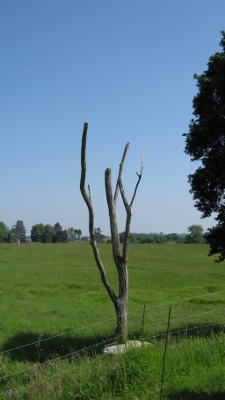Beaumont-Hamel National Historic Site of Canada
Beaumont-Hamel

General view of 'Danger Tree'
© Parks Canada Agency | Agence Parcs Canada, S. Desjardins, 2009.
Address :
Highway D73, Beaumont-Hamel
Recognition Statute:
Historic Sites and Monuments Act (R.S.C., 1985, c. H-4)
Designation Date:
1996-11-19
Event, Person, Organization:
-
First World War
(Event)
-
Battle of the Somme
(Event)
-
Major Thomas Nangle
(Person)
-
1st Newfoundland Regiment
(Organization)
-
Royal Newfoundland Regiment
(Organization)
-
Royal Naval Reserve
(Organization)
-
Newfoundland Mercantile Marine
(Organization)
-
29th British Division
(Organization)
-
Basil Gotto
(Builder)
Other Name(s):
-
Beaumont-Hamel
(Designation Name)
-
Newfoundland Beaumont Hamel Memorial Park
(Other Name)
Research Report Number:
1996-042
Plaque(s)
Existing plaque: Beaumont-Hamel Newfoundland Memorial
Beaumont-Hamel symbolizes the service and sacrifice of Newfoundlanders during the First World War. This park pays special tribute to the role of the Newfoundland Regiment in the Battle of the Somme and the heavy losses it suffered. The park also stands as a memorial to those Newfoundlanders who fell in battle and who have no known grave.
The Newfoundland Regiment participated in the great Somme offensive where, on 1 July 1916, strategic and tactical miscalculations led to a terrible slaughter. Despite its horrific casualties, the Regiment fought until 1918. For its valour, it won the right to add "Royal" to its name, the only such honour bestowed during the Great War.
Once a battlefield, Beaumont-Hamel became, in 1922, a memorial park conceived by Padre Thomas Nangle and planned by Rudolph H. K. Cochius. Its design evokes the Newfoundland environment: overlooking the battlefield stands a bronze caribou resting on a granite base surrounded by plants native to the island. Three bronze tablets bear the names of Newfoundlanders buried elsewhere. This memorial park honours those soldiers and ensures that their sacrifice will never be forgotten.
Existing plaque: Memorial University Newfoundland and Labrador
Description of Historic Place
Beaumont-Hamel National Historic Site of Canada is located in northern France, nine kilometres north of the town of Albert. Part of the western front during the First World War, this site comprises two main resources: the preserved core of the battlefield and the memorial monument erected in 1922-1924. It serves as the principal memorial to all Newfoundlanders who served in the Great War in France and Belgium, to those killed and to those with no known grave. The battlefield landscape retains significant features, which include the Allied trenches occupied by the Newfoundlanders, shell craters, saps, tunnels, and also the German lines. On a rise of land in the battlefield, the Government of Newfoundland erected a cairn of Newfoundland granite that resembles a natural outcrop. Upon the cairn stands a majestic bronze caribou, the emblem of the Royal Newfoundland Regiment, its antlered head facing the German trenches. Official recognition refers to the whole 25-hectare site, its component parts including the remains of the battlefield and the war memorial in their existing spatial relationships.
Heritage Value
Beaumont-Hamel was designated a national historic site of Canada in 1997 because: Newfoundland's accomplishment, contribution and sacrifice in the First World War are themselves of major national significance; the loss of Newfoundlanders in the First World War had a profound impact on the colony; Beaumont-Hamel speaks eloquently to the bravery and sacrifice of the Royal Newfoundland Regiment at the Battle of the Somme on July 1, 1916; it memorializes Newfoundlanders lost in the conflict who have no known grave.
On July 1st, 1916, the first day of the battle of the Somme, over seven hundred members of the First Newfoundland Regiment were either killed or wounded in fierce fighting during an Allied attack against the German Army. Advancing steadily in formation over open ground against strongly held German defences, the regiment suffered horrific losses that devastated Newfoundland and had a profound impact on the colony. Determined to erect a permanent memorial to their dead, the Government of Newfoundland acquired a 25-hectare portion of the battlefield in the early 1920s. The battlefield was preserved, and a memorial park was created with plantings, pathways, fences, and a central large cairn, featuring a life-sized bronze sculpture of a caribou. Other plaques and memorials have also been installed in the park. Upon entry into Confederation in 1949, the Beaumont-Hamel war memorial has been managed by the Department of Veterans Affairs on behalf of the Province of Newfoundland and Labrador, and all of the people of Canada.
Source: Historic Sites and Monuments Board of Canada, Minutes, November 1996; Commemorative Integrity Statement, June 1997.
Character-Defining Elements
Key elements contributing to the heritage value of this site include: its location in Northern France, nine kilometres north of the town of Albert; its siting on a landscape associated with the Western Front and the Battle of the Somme; the topographical features and natural landscape orientation, which formed an important part of the military tactics of the opposing German forces and which communicate in part the tragic casualties of the assault on Beaumont-Hamel; the battlefield as a cemetery, as well as the formally designed cemeteries on the site; the site of the ‘Danger Tree’; the ‘Y’ Ravine; the site’s surviving battlefield remains, including shell holes, craters, trenches, dugouts, tunnels, archaeological resources and in situ German strong points representative of the Western Front of the First World War; the memorial features of the landscape, including the original perimeter fencing, the original planting scheme with its locations and choices of plant species some native to Newfoundland; the monumental sculpture of the bronze caribou on its plinth; the original network of paths; the ceremonial entrance; all other memorials and plaques, including the three bronze plaques at the base of the statue that bear the names of 814 members of the Royal Newfoundland Regiment, the Newfoundland Royal Naval Reserve and the Mercantile Marine who gave their lives in the First World War and have no known grave; viewscapes to Hawthorne Cemetery Number One and the Hawthorne Crater; viewscapes from the north side of the Park toward the village of Beaumont Hamel and the ‘Y’ Ravine.